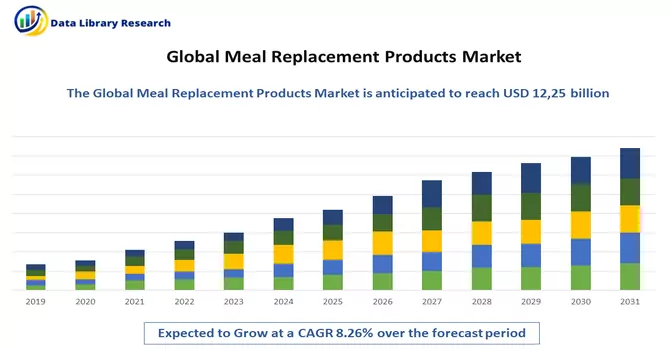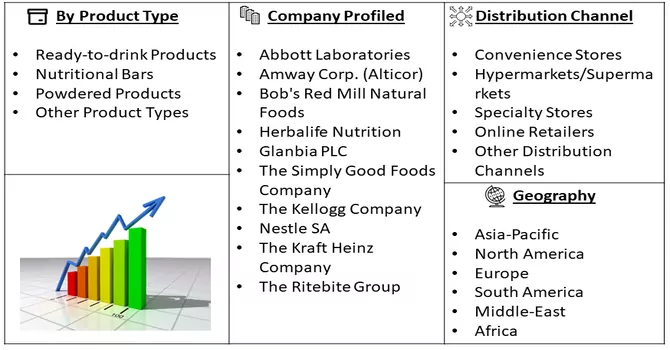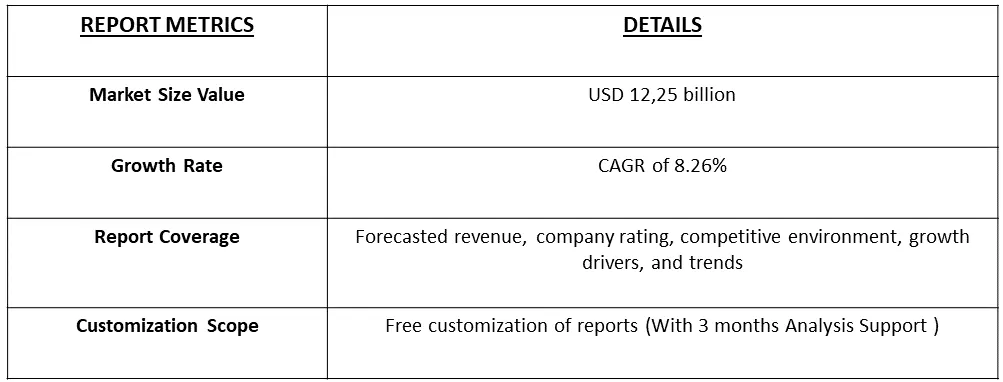The Meal Replacement Products Market size is estimated at USD 12,25 billion in 2023 and is expected to register a CAGR of 8.26% during the forecast period (2024-2031).

Get Complete Analysis Of The Report - Download Free Sample PDF
The meal replacement products market has established a strong presence in Western countries, particularly in Europe and North America. However, the Asia-Pacific region is poised for significant growth in the coming years. The global impact of the coronavirus has affected economies worldwide, creating potential challenges for economic growth. Despite this, the prevalence of health issues like obesity, diabetes, and cardiovascular diseases is expected to boost consumer awareness about weight loss and management diets, driving the demand for meal replacement products.
These products, containing 200 to 400 calories along with essential nutrients, offer a convenient and comprehensive dietary option, contributing to their increasing popularity. Meal replacement products are particularly appealing to individuals on special diets, including those managing weight or monitoring blood sugar levels due to diabetes. Additionally, the market targets consumers with busy lifestyles and time constraints, providing a healthier and nutritionally balanced alternative to conventional snacks. This shift towards meal replacement products reflects evolving dietary preferences and a growing emphasis on convenient yet nutritious food choices.
The global meal replacement products market is experiencing notable trends that reflect evolving consumer preferences and health-conscious lifestyles. One prominent trend is the increasing demand for personalized nutrition, with consumers seeking customized meal replacement options tailored to their specific dietary needs and wellness goals. This shift is driving innovation in the market, leading to the development of diverse products that cater to various dietary preferences, including plant-based, keto-friendly, and allergen-free options. Another significant trend is the growing focus on clean label and natural ingredients. Consumers are increasingly inclined towards meal replacement products that feature transparent and easily recognizable ingredient lists, free from artificial additives and preservatives. This demand aligns with the broader trend of clean eating and a preference for wholesome, minimally processed foods. The market is also witnessing a surge in functional meal replacements, incorporating ingredients such as probiotics, prebiotics, vitamins, and minerals. These products go beyond basic nutrition, offering additional health benefits, including digestive wellness and immune support. Moreover, the convenience factor remains a key driver, with busy lifestyles and on-the-go consumption influencing product innovation. Ready-to-drink shakes, bars, and powders that can be easily incorporated into daily routines are gaining popularity, appealing to consumers looking for convenient and nutritious meal option. Thus, the global meal replacement products market is shaped by these trends, reflecting a dynamic landscape where customization, clean label preferences, functional ingredients, and convenience converge to meet the diverse demands of health-conscious consumers.
Market Segmentation: The Global Meal Replacement Products Market is Segmented by Product Type (Ready-to-drink Products, Nutritional Bars, Powdered Products, and Other Product Types), Distribution Channel (Convenience Stores, Hypermarkets/Supermarkets, Specialty Stores, Online Retailers, Other Distribution Channels), and Geography (North America, Asia-Pacific, Europe, South America, Middle-East and Africa). The report offers market size and forecasts in value (USD million) for all the above segments.

For Detailed Market Segmentation - Download Free Sample PDF
Market Drivers:
Increasing awareness about health and wellness is a significant driver for the global meal replacement products market
The global meal replacement products market is witnessing a substantial surge, primarily driven by the increasing awareness about health and wellness among consumers. With a growing emphasis on adopting healthier lifestyles, individuals are actively seeking convenient and nutritionally balanced alternatives to traditional meals. The awareness about the impact of diet on overall well-being, weight management, and preventive healthcare measures has led to a shift in dietary choices. Consumers are now more informed about the importance of consuming balanced nutrients and are turning to meal replacement products as a convenient means to meet their dietary goals. These products offer a controlled and regulated intake of calories, proteins, vitamins, and minerals, aligning with health-conscious consumers' preferences. The desire for weight management, coupled with a broader understanding of the role of nutrition in supporting various aspects of health, has fueled the adoption of meal replacement products. Whether targeting specific health conditions, such as obesity or diabetes, or simply aiming for a more balanced diet, consumers are recognizing the potential benefits of incorporating meal replacements into their daily routines. As a result, manufacturers in the meal replacement products market are responding to this heightened awareness by innovating and diversifying their product offerings to cater to different dietary preferences and health goals. The increasing awareness about health and wellness stands as a pivotal driver, shaping the landscape of the meal replacement products market and influencing consumer choices towards healthier and more convenient dietary options.
The rise in hectic schedules and busy lifestyles has fueled the demand for on-the-go and easy-to-prepare meal solutions.
The surge in hectic schedules and busy lifestyles has become a driving force behind the escalating demand for on-the-go and easy-to-prepare meal solutions, significantly impacting the Meal Replacement Products Market. Modern-day consumers, grappling with time constraints, are increasingly seeking convenient yet nutritionally balanced alternatives to traditional meals. The demand for meal replacement products has soared as individuals strive to maintain a healthy diet amidst their fast-paced lives. These products offer a quick and hassle-free solution, allowing individuals to meet their dietary needs without compromising nutritional value. Ready-to-drink shakes, bars, and powdered meal replacements have gained prominence as convenient options that can be easily incorporated into busy routines. This trend aligns with the need for portable and efficient meal choices, catering to individuals who find it challenging to dedicate time to conventional meal preparation. The meal replacement products market is responding to this lifestyle-driven demand by introducing innovative and diverse offerings that prioritize both convenience and nutritional content. As consumers continue to prioritize time-saving solutions without compromising on health, the market for on-the-go meal replacements is poised for sustained growth, reshaping dietary habits in tandem with the evolving dynamics of modern living.
Market Restraints:
Regulatory Scrutiny and Labeling Challenges
Meeting stringent regulations and facing increased scrutiny on nutritional claims and labeling poses a significant challenge for the meal replacement products industry. Governments and regulatory bodies worldwide are enforcing strict standards to ensure accuracy and transparency in nutritional information, health claims, and marketing assertions. Compliance with evolving regulations requires constant adaptation to changing standards and demands meticulous attention to detail. Non-compliance can result in legal consequences, product recalls, and damage to brand reputation. Navigating global markets adds complexity due to regional variations in regulatory frameworks. As consumers demand transparency, adherence to rigorous regulations becomes not only a legal obligation but also a critical factor influencing the marketing, sale, and overall success of meal replacement products. Manufacturers must stay informed, engage with regulatory authorities, and invest in thorough research to navigate this intricate landscape effectively.
The global lockdown enforced during the COVID-19 pandemic presented unparalleled health challenges, prompting a significant shift in consumer lifestyles that has come to be recognized as the new normal. With restricted movements and altered routines, individuals faced heightened stress, increased instances of overeating, and a surge in weight gain. Against this backdrop, healthy eating emerged as a paramount concern, with consumers prioritizing efforts to bolster their immune systems. This heightened awareness of personal health and well-being substantially contributed to the surge in sales of meal replacement products in the market. Recognizing the need for convenient and nutritious options amidst the challenges posed by the pandemic, consumers turned to meal replacements as a practical solution, further emphasizing the market's role in supporting individuals in maintaining a balanced and health-conscious lifestyle during unprecedented times.
Segmental Analysis:
Nutrition Bars Segment is Expected to Witness Significant Growth Over the Forecast Period
Nutrition bars serve as convenient and portable sources of essential nutrients, offering a quick and accessible way to meet dietary requirements. These bars are crafted to provide a balanced combination of proteins, fibers, vitamins, and minerals, making them suitable for various nutritional needs. Commonly used as on-the-go snacks, pre or post-workout fuel, or meal replacements, nutrition bars cater to individuals with busy lifestyles. Their versatility extends to supporting weight management, boosting energy levels, and aiding in muscle recovery. The compact and shelf-stable nature of nutrition bars makes them a practical choice for those seeking a nutritious and convenient dietary supplement.
Hypermarkets/Supermarkets Segment is Expected to Witness Significant Growth Over the Forecast Period
Hypermarkets and supermarkets play a pivotal role in the distribution and accessibility of ready-to-eat (RTE) food products. These retail giants offer a diverse array of RTE options, ranging from packaged meals and snacks to salads and sandwiches. Their extensive shelf space allows consumers to choose from a wide selection of convenient and quick meal solutions. Hypermarkets and supermarkets leverage their robust supply chains to ensure a constant stock of fresh and packaged RTE items, meeting the demands of time-pressed consumers seeking on-the-go or hassle-free meal options. The convenience, variety, and accessibility provided by these retail establishments contribute significantly to the popularity and widespread consumption of ready-to-eat foods.
North America Region is Expected to Witness Significant Growth Over the Forecast Period
In 2021, the North American region dominated the meal replacement products market, securing the largest share in terms of revenue. The United States emerged as the frontrunner in this market, with local players introducing innovative products like low-calorie and healthy protein shakes. This trend has significantly elevated the popularity of meal replacement products among consumers in the region. Additionally, there is a growing focus on addressing consumer preferences for organic options, leading to the introduction of all-organic meal replacement shakes by market players. The multi-purpose functionality and on-the-go convenience of meal replacement products, particularly beverages, are key factors driving consumer interest across North America. The region benefits from a robust network of retail outlets specializing in convenient foods, uniquely positioned to capitalize on both planned and impulse purchases, providing a strategic advantage not shared by other snack categories.

Get Complete Analysis Of The Report - Download Free Sample PDF
The meal replacement products market exhibits intense competition, with the leading players collectively holding a substantial 50% of the total market share. Manufacturers in this sector are strategically augmenting their investments in research and development, marketing endeavours, and product innovation. By prioritizing these areas, they aim to enhance the quality and appeal of their offerings. Additionally, these market leaders are actively expanding their distribution channels, ensuring a broader reach for their products. The competitive landscape is characterized by a constant pursuit of maintaining and strengthening market positions, where sustained investments in R&D and strategic marketing play a pivotal role in navigating the dynamic preferences of health-conscious consumers. Some the market players are:
Recent Development:
1) November 2022: Levana Nourishment introduced a line of plant-based meal replacement shakes in vanilla bean, mixed berry, and cocoa-coffee varieties.
2) March 2022: Southern Charm Nutrition opened its outlet in downtown Fairmont. The store will serve loaded tea and coffee bombs, as well as full meal replacement shakes. All their shakes have 17 to 24 g of protein, are under 270 calories, and are available in a wide range of flavours.
Q1. What was the Meal Replacement Products Market size in 2023?
As per Data Library Research the Meal Replacement Products Market size is estimated at USD 12,25 billion in 2023.
Q2. At what CAGR is the Meal Replacement Products market projected to grow within the forecast period?
Meal Replacement Products Market is expected to register a CAGR of 8.26% during the forecast period.
Q3. What segments are covered in the Meal Replacement Products Market Report?
By Product Type, Application and Geography these segments are covered in the Meal Replacement Products Market Report.
Q4. Which Region is expected to hold the highest Market share?
North America region is expected to hold the highest Market share.
Data Library Research are conducted by industry experts who offer insight on industry structure, market segmentations technology assessment and competitive landscape (CL), and penetration, as well as on emerging trends. Their analysis is based on primary interviews (~ 80%) and secondary research (~ 20%) as well as years of professional expertise in their respective industries. Adding to this, by analysing historical trends and current market positions, our analysts predict where the market will be headed for the next five years. Furthermore, the varying trends of segment & categories geographically presented are also studied and the estimated based on the primary & secondary research.
In this particular report from the supply side Data Library Research has conducted primary surveys (interviews) with the key level executives (VP, CEO’s, Marketing Director, Business Development Manager and SOFT) of the companies that active & prominent as well as the midsized organization
FIGURE 1: DLR RESEARH PROCESS

Extensive primary research was conducted to gain a deeper insight of the market and industry performance. The analysis is based on both primary and secondary research as well as years of professional expertise in the respective industries.
In addition to analysing current and historical trends, our analysts predict where the market is headed over the next five years.
It varies by segment for these categories geographically presented in the list of market tables. Speaking about this particular report we have conducted primary surveys (interviews) with the key level executives (VP, CEO’s, Marketing Director, Business Development Manager and many more) of the major players active in the market.
Secondary ResearchSecondary research was mainly used to collect and identify information useful for the extensive, technical, market-oriented, and Friend’s study of the Global Extra Neutral Alcohol. It was also used to obtain key information about major players, market classification and segmentation according to the industry trends, geographical markets, and developments related to the market and technology perspectives. For this study, analysts have gathered information from various credible sources, such as annual reports, sec filings, journals, white papers, SOFT presentations, and company web sites.
Market Size EstimationBoth, top-down and bottom-up approaches were used to estimate and validate the size of the Global market and to estimate the size of various other dependent submarkets in the overall Extra Neutral Alcohol. The key players in the market were identified through secondary research and their market contributions in the respective geographies were determined through primary and secondary research.
Forecast Model
